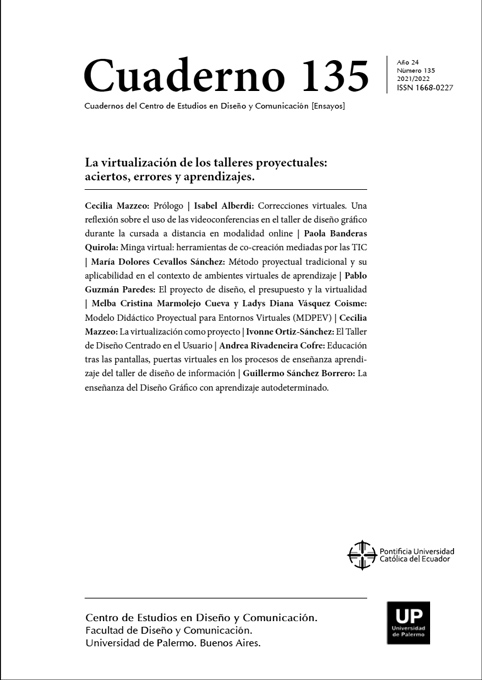Educación tras las pantallas, puertas virtuales en los procesos de enseñanza aprendizaje del taller de diseño de Información
Abstract
The public health situation forced us all to stand behind a screen to continue with the work, university education was no exception. How to deal with this virtuality in careers such as Design that are of practical application and whose methodology is based on the realization of development projects in practical workshops? Connectivity and the teaching model are two determining factors that have been evident in the virtualization of project workshops; according to the newspaper El Comercio (2020) home computer equipment must be shared by the whole family, adults tele-working, university students connected for many hours, all connected simultaneously, are some of the connectivity problems that have had to be faced in the education processes. Let us start with the main factor and on which we have a great impact, the educational model; The Graphic Design career presents in his redesign document (2017) the strategies and teaching techniques where the student is responsible for his learning, he is who should search, select, analyze and evaluate the information for the construction of his knowledge and for this to happen the teacher must plan the experiences that he wants to develop in the student as well as guide , motivate and help students during this process. The virtualization to which the pandemic took us made us show how we are applying these strategies and teaching techniques established in the micro curriculum. Frascara (2018) tells us that design teaching must be organized, based on problem solving in the form of projects, that is where we start our teaching work to address this virtuality in education, the comprehensive planning of the activities, spaces, resources and even connectivity difficulties that students will have to face in order to generate knowledge. In this process the participation and active communication of teachers was vital for this development, monitoring methodologies, activities, advances and above all student difficulties.
References
Entre la baja conectividad y el exceso de pantallas (14 de septiembre 2020). El Comercio. Recuperado de: https://www.elcomercio.com/opinion/editorial/editorial-elcomercio-baja-conectividad-pantallas.html
PUCE, C. de D. G. (2019). Declaración del Ajuste del Rediseño Curricular de la Carrera de Diseño Gráfico PUCE. Quito.
Pullas, P. (2019). Modelo pedagógico para la formación continua, modalidad virtual. Dialnet. https://dialnet.puce.elogim.com/servlet/tesis?codigo=270759
Sangrà, A. (2020). Decálogo para la mejora de la docencia online. Barcelona. Editorial UOC. X. F. Jiménez, A. S. Quelal y G. Sánchez (2020), La nueva enseñanza del Diseño, Cuaderno 104 | Centro de Estudios en Diseño y Comunicación, ISSN 1668-0227
Esther Rando Burgos (2020). El proceso de enseñanza y aprendizaje ante el tránsito de la docencia presencial a la docencia virtual universitaria provocada por la Covid. Edunovatic 2020. https://dialnet.puce.elogim.com/servlet/libro?codigo=787743
Alba, C; Moral, S; Gutierrez, P. (2020). Adaptación online de la Educación Universitaria. Edunovatic 2020. https://dialnet.puce.elogim.com/servlet/libro?codigo=787743
Martinelli, S; Cuzzani, K. (2017). ¿Las TIC incluyen? Aulas virtuales para estudiantes, primera generación de universitarios en la UNPAZ. Trayectorias Universitarias. https://revistas.unlp.edu.ar/TrayectoriasUniversitarias/article/view/3870
Tedesco, J. (2000). Educar en la sociedad del conocimiento. Buenos Aires. Fondo de Cultura Económica de Argentina S. A.
Suárez, B. (2018). Whatsapp: su uso educativo, ventajas y desventajas, Revista de investigación en educación. Dialnet. ISSN 1697-5200. https://dialnet.puce.elogim.com/servlet/articulo?codigo=6636915
Los autores/as que publiquen en esta revista ceden los derechos de autor y de publicación a "Cuadernos del Centro de Estudios de Diseño y Comunicación", Aceptando el registro de su trabajo bajo una licencia de atribución de Creative Commons, que permite a terceros utilizar lo publicado siempre que de el crédito pertinente a los autores y a esta revista.


